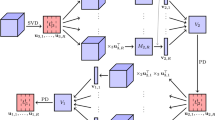Abstract
A successive unconstrained dual optimization (SUDO) method is developed to solve the high order tensors’ best rank-one approximation problems, in the least-squares sense. The constrained dual program of tensors’ rank-one approximation is transformed into a sequence of unconstrained optimization problems, for where a fast gradient method is proposed. We introduce the steepest ascent direction, a initial step length strategy and a backtracking line search rule for each iteration. A proof of the global convergence of the SUDO algorithm is given. Preliminary numerical experiments show that our method outperforms the alternating least squares (ALS) method.
Similar content being viewed by others
References
Barzilai, J., Borwein, J.M.: Two-point step size gradient methods. IMA J. Numer. Anal. 8, 141–148 (1988)
Carroll, J., Chang, J.: Analysis of individual differences in multidimensional scaling via an N-way generalization of “Eckart-Young” decomposition. Psychometrika 35, 283–319 (1970)
Chang, J., Sun, W., Chen, Y.: A modified Newton’s method for best rank-one approximation to tensors. Appl. Math. Comput. 216, 1859–1867 (2010)
Han, D., Qi, L., Wu, X.: Extreme diffusion values for non-Gaussian diffusions. Optim. Methods Softw. 23, 703–716 (2008)
Harshman, R.: Foundations of the PARAFAC procedure: model and conditions for a ‘explanatory’ multi-mode factor analysis. UCLA Work. Pap. Phon. 16, 1–84 (1970)
Kolda, T.G., Bader, B.W.: Tensor decompositions and applications. SIAM Rev. 51, 455–500 (2009)
Kofidis, E., Regalia, P.A.: On the best rank-1 approximation of higher-order supersymmetric tensors. SIAM J. Matrix Anal. Appl. 23, 863–884 (2002)
Lathauwer, L.D.: Decompositions of a high-order tensor in block terms. Part I. Lemmas for partitioned matrices. SIAM J. Matrix Anal. Appl. 30, 1022–1032 (2008)
Lathauwer, L.D.: Decompositions of a high-order tensor in block terms. Part II. Definitions and uniqueness. SIAM J. Matrix Anal. Appl. 30, 1033–1066 (2008)
Lathauwer, L.D., Nion, D.: Decompositions of a high-order tensor in block terms. Part III. Alternating least squares algorithms. SIAM J. Matrix Anal. Appl. 30, 1067–1083 (2008)
Lathauwer, L.D., De Moor, B., Vandewalle, J.: A multilinear singular value decomposition. SIAM J. Matrix Anal. Appl. 21, 1253–1278 (2000)
Lathauwer, L.D., De Moor, B., Vandewalle, J.: On the best rank-1 and rank-(R 1,R 2,…,R N ) approximation of higher-order tensors. SIAM J. Matrix Anal. Appl. 21, 1324–1342 (2000)
Lathauwer, L.D., Moor, B. De, Vandewalle, J.: Fetal Electrocardiogram Extraction by blind source subspace separation. IEEE Trans. Signal Process. 47, 567–572 (2000)
Nion, D., Lathauwer, L. De: A block component model-based blind DS-CDMA recerver. IEEE Trans. Signal Process. 56, 5567–5579 (2008)
Qi, L., Sun, W., Wang, Y.: Numerical multilinear algebra and its applications. Front. Math. Chin. 2, 501–526 (2007)
Rajih, M., Comon, P., Harshman, R.A.: Enhanced line search: a novel method to accelerate PARAFAC. SIAM J. Matrix Anal. Appl. 30, 1128–1147 (2008)
Sidiropoulos, N.D., Giannakis, G.B., Bro, R.: Blind PARAFAC receiver for DS-CDMA systems. IEEE Trans. Signal Process. 48, 810–823 (2000)
Sun, W., Yuan, Y.: Optimization theory and methods: nonlinear programming. Springer, Berlin (2006)
Tucker, L.: Some mathematical notes on three mode factor analysis. Psychometrika 31, 279–311 (1966)
Zhang, T., Golub, G.H.: Rank-one approximation to high order tensors. SIAM J. Matrix Anal. Appl. 23, 534–550 (2001)
Author information
Authors and Affiliations
Corresponding author
Rights and permissions
About this article
Cite this article
Chen, Y. Successive unconstrained dual optimization method for rank-one approximation to tensors. J. Appl. Math. Comput. 38, 9–23 (2012). https://doi.org/10.1007/s12190-010-0459-7
Received:
Published:
Issue Date:
DOI: https://doi.org/10.1007/s12190-010-0459-7




